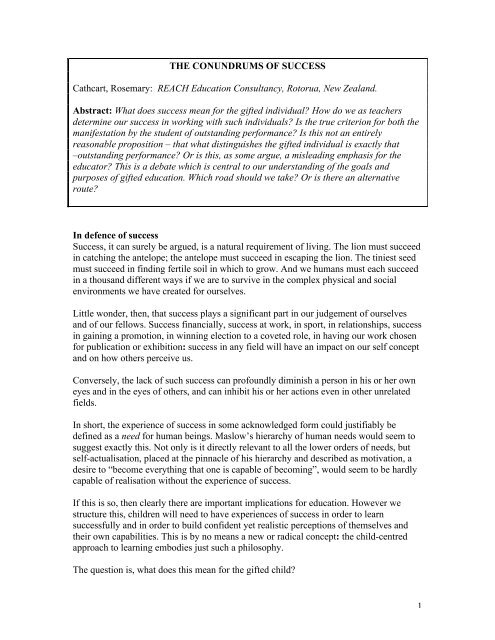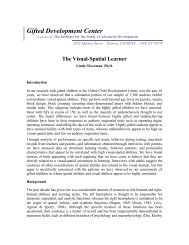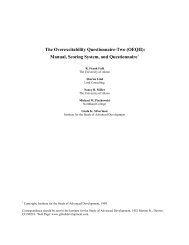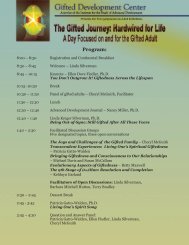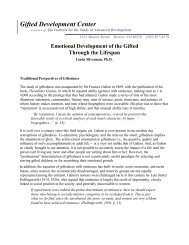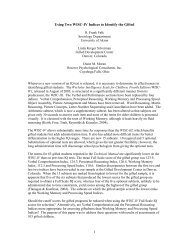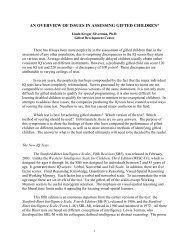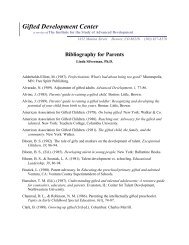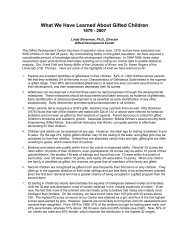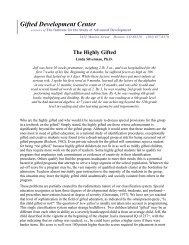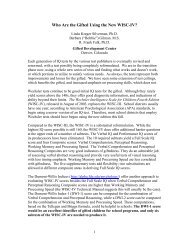THE CONUNDRUMS OF SUCCESS - the Gifted Development Center
THE CONUNDRUMS OF SUCCESS - the Gifted Development Center
THE CONUNDRUMS OF SUCCESS - the Gifted Development Center
Create successful ePaper yourself
Turn your PDF publications into a flip-book with our unique Google optimized e-Paper software.
<strong>THE</strong> <strong>CONUNDRUMS</strong> <strong>OF</strong> <strong>SUCCESS</strong>Cathcart, Rosemary: REACH Education Consultancy, Rotorua, New Zealand.Abstract: What does success mean for <strong>the</strong> gifted individual? How do we as teachersdetermine our success in working with such individuals? Is <strong>the</strong> true criterion for both <strong>the</strong>manifestation by <strong>the</strong> student of outstanding performance? Is this not an entirelyreasonable proposition – that what distinguishes <strong>the</strong> gifted individual is exactly that–outstanding performance? Or is this, as some argue, a misleading emphasis for <strong>the</strong>educator? This is a debate which is central to our understanding of <strong>the</strong> goals andpurposes of gifted education. Which road should we take? Or is <strong>the</strong>re an alternativeroute?In defence of successSuccess, it can surely be argued, is a natural requirement of living. The lion must succeedin catching <strong>the</strong> antelope; <strong>the</strong> antelope must succeed in escaping <strong>the</strong> lion. The tiniest seedmust succeed in finding fertile soil in which to grow. And we humans must each succeedin a thousand different ways if we are to survive in <strong>the</strong> complex physical and socialenvironments we have created for ourselves.Little wonder, <strong>the</strong>n, that success plays a significant part in our judgement of ourselvesand of our fellows. Success financially, success at work, in sport, in relationships, successin gaining a promotion, in winning election to a coveted role, in having our work chosenfor publication or exhibition: success in any field will have an impact on our self conceptand on how o<strong>the</strong>rs perceive us.Conversely, <strong>the</strong> lack of such success can profoundly diminish a person in his or her owneyes and in <strong>the</strong> eyes of o<strong>the</strong>rs, and can inhibit his or her actions even in o<strong>the</strong>r unrelatedfields.In short, <strong>the</strong> experience of success in some acknowledged form could justifiably bedefined as a need for human beings. Maslow’s hierarchy of human needs would seem tosuggest exactly this. Not only is it directly relevant to all <strong>the</strong> lower orders of needs, butself-actualisation, placed at <strong>the</strong> pinnacle of his hierarchy and described as motivation, adesire to “become everything that one is capable of becoming”, would seem to be hardlycapable of realisation without <strong>the</strong> experience of success.If this is so, <strong>the</strong>n clearly <strong>the</strong>re are important implications for education. However westructure this, children will need to have experiences of success in order to learnsuccessfully and in order to build confident yet realistic perceptions of <strong>the</strong>mselves and<strong>the</strong>ir own capabilities. This is by no means a new or radical concept: <strong>the</strong> child-centredapproach to learning embodies just such a philosophy.The question is, what does this mean for <strong>the</strong> gifted child?1
The term "gifted" connotes a mature power ra<strong>the</strong>r than a developing ability and,<strong>the</strong>refore, is anti<strong>the</strong>tic to recent research findings about children.It <strong>the</strong>n went on to offer a new definition replacing “gifted” with “talented” and beginningthus:Children and youth with outstanding talent perform or show <strong>the</strong> potential forperforming at remarkably high levels of accomplishment when compared witho<strong>the</strong>rs of <strong>the</strong>ir age, experience, or environment.These children and youth exhibit high performance capability in intellectual,creative, and/or artistic areas, possess an unusual leadership capacity, or excel inspecific academic fields.(OERI, 1993, p.26) Thus <strong>the</strong> focus is placed very specifically on various kinds ofperformance - those tangible outcomes which can in some way be quantified, measuredor observed, or at least predicted with some degree of accuracy.A reasonable approach?Our first response to this may be to say that it appears to be entirely reasonable. Surelywe do expect <strong>the</strong> gifted to produce work at a gifted level, at least sufficiently often for itto be seen, measured or recorded in some objective way? Isn’t that <strong>the</strong> whole point, wemay ask.Very relevant to this debate, teachers’ subjective judgements about children’s ability arenotoriously unreliable. As far back as 1959, Pegnato and Birch (cited in Clark, 2002,p.334) found that of every 100 students teachers named as gifted, only 26% actuallywere, while at <strong>the</strong> same time teachers failed to identify some 55% of <strong>the</strong> genuinely gifted.All of us who work in <strong>the</strong> field can provide reams of anecdotal evidence that still todaymany teachers have only <strong>the</strong> vaguest idea of what constitutes exceptional ability – like<strong>the</strong> teacher who told me that a certain child must be gifted because “she writes so neatly”,<strong>the</strong> o<strong>the</strong>r side of <strong>the</strong> same coin as all those teachers who insist that a child cannot possiblybe gifted because <strong>the</strong>ir work is untidy, illegible or unfinished. And so on!Well-intentioned as <strong>the</strong>y undoubtedly are, if attitudes like <strong>the</strong>se are even moderatelytypical, <strong>the</strong>n tangible products or performance (especially <strong>the</strong> hard data of test scores)must surely be a more effective way of finding <strong>the</strong> gifted (or <strong>the</strong> talented) than relying onteacher opinion.Standardised testing, in contrast to individual teacher opinion, draws on a largepopulation sample, producing definitive norms, and <strong>the</strong>refore surely gives us moreaccurate classification than does teacher judgement. Secondly it is much easier and lesstime-consuming for <strong>the</strong> teacher than trying to make qualitative judgements, so schoolsare more likely to buy into such a process. Overall <strong>the</strong> result would logically seem to bethat if we use this approach, we will have a better idea of how many children are likely to3
and against those from different cultural backgrounds, and thus use <strong>the</strong>m judiciously toinclude ra<strong>the</strong>r than to exclude.That, I think, is well established, but we are perhaps less familiar with <strong>the</strong> possibility thattest results can be manipulated to achieve ends that have nothing to do with children’sreal welfare. For example, where such testing is used as <strong>the</strong> sole criterion for entry togifted programmes with a cut-off point being set, <strong>the</strong>re have been reported instanceswhere <strong>the</strong> cut-off points have been raised or lowered in different years according to howmuch funding <strong>the</strong> education authority was prepared to make available. Raise <strong>the</strong> cut-offpoint, and lo and behold, fewer gifted students, less funding required – a strategy notaltoge<strong>the</strong>r unknown in o<strong>the</strong>r governmental activities.In short, an identification process based purely on performance neatly serves <strong>the</strong> interestsof those teachers who want black-and-white solutions which require no challenge to <strong>the</strong>irthinking, time or energy, and those administrators who want systems that are easy tomanage and involve minimal expenditure. It may sometimes serve <strong>the</strong> interests of thosewho have a particular political or social agenda.It does not, and never can, serve <strong>the</strong> best interests of <strong>the</strong> gifted child.The first conundrumThus we see <strong>the</strong> first example of <strong>the</strong> conundrum: if we focus on success, <strong>the</strong>n when itcomes to identification, we will at least partially fail.But this notion of focussing on measurable performance casts a much longer shadow on<strong>the</strong> future of <strong>the</strong> gifted child than simply at <strong>the</strong> moment of identification, even for thosewho make it through this channelled gateway and are recognised for what <strong>the</strong>y are.If we believe that measurable performance or achievement is <strong>the</strong> sole criterion ofgiftedness, <strong>the</strong>n this belief shapes, not only how we try to identify <strong>the</strong> gifted child, butalso everything we <strong>the</strong>n do for <strong>the</strong> gifted child. It determines <strong>the</strong> nature and scope of <strong>the</strong>provisions we put in place. It defines <strong>the</strong> goals we set for <strong>the</strong> child and for ourselves. Itdecides for us how we will monitor and evaluate what we do. And just as usingperformance as a criterion can limit our ability to identify gifted learners, so it can limitour ability to provide for <strong>the</strong>m.Let me give you an example of this in practice. Some years ago I had a connection with ahigh school whose principal was totally dedicated to <strong>the</strong> view that <strong>the</strong> whole business ofidentifying and catering for gifted students revolved around achieving high levelperformance. Thus <strong>the</strong> entire programme for <strong>the</strong>se students from Year 9 onwards wasdriven by his determination that in Year 13 every one of <strong>the</strong>m would gain an “A” bursaryin <strong>the</strong> Scholarship exam which was <strong>the</strong>n <strong>the</strong> country’s highest external exam. To that endhe chose <strong>the</strong>ir subject options for <strong>the</strong>m at every level, regardless of <strong>the</strong>ir personalpreferences. His view, publicly stated, was that gifted students should have fewer choicesthan o<strong>the</strong>r students. He applied that in various ways. For example, one student whowanted to take journalism in her Year 12 year as a prerequisite for tertiary study in her5
chosen career was refused permission to do so because it was not a Scholarship subject.When some schools opted into ano<strong>the</strong>r externally monitored exam outside <strong>the</strong> Ministryrequirements, he insisted that his gifted students take this too. The students as a group didnot want to do so, wishing instead to concentrate on <strong>the</strong>ir current exams. He and <strong>the</strong>deputy principal repeatedly visited <strong>the</strong>ir class and relentlessly harangued <strong>the</strong>m until <strong>the</strong>yfinally gave in. Two who held out were individually interviewed and pressured to change<strong>the</strong>ir minds; <strong>the</strong>ir parents were similarly lectured, and subsequently expressed <strong>the</strong>ir angerat such harassment of <strong>the</strong>mselves and <strong>the</strong>ir children. The same principal refused to giveone boy leave from school when he was selected to play soccer for a New Zealand juniorteam. The reason? The school prioritised rugby. Boys gifted in sport should make that<strong>the</strong>ir focus.I knew this principal, and I have absolutely no doubt that he was sincere in his belief tha<strong>the</strong> was doing <strong>the</strong> right thing for all <strong>the</strong>se students. But perhaps <strong>the</strong> underlying attitude inthat school to students as people was best summed up by <strong>the</strong> Board member who referredto students as “units of production”.This may seem an extreme case. I certainly trust and believe that it is. Valuing academicachievement is very definitely NOT wrong, entirely <strong>the</strong> reverse. I would like toemphasise that statement. It is certainly something I personally value very highly. (For<strong>the</strong> record, I’m a rugby fan too!) I want to acknowledge here that <strong>the</strong>re are many, manyschools who support <strong>the</strong>ir students in reaching academic and indeed sportingachievement without going to <strong>the</strong> extremes that this principal did.And yet this school was regarded as one of our “good” schools, solely because of <strong>the</strong>high marks gained by a handful of its students in an external exam. This highlights for us<strong>the</strong> second part of our conundrum. What part should success play in setting our goals forgifted students and deciding whe<strong>the</strong>r those have been reached? Is quantifiable or visibleachievement <strong>the</strong> best or <strong>the</strong> only measure of success? If not, what o<strong>the</strong>r measure could wepossibly use?The great divideThis is a question of paramount importance for both parents and teachers. When we areparents, it is one of <strong>the</strong> key questions to shape our enquiries about our child’s progressfrom <strong>the</strong> day he or she first enters school. Is he or she doing well? How do we know? Ifmarks and grades and test results are good, does that mean <strong>the</strong>re’s nothing to worryabout? Later, when it’s time to move from <strong>the</strong> local primary to <strong>the</strong> big world of <strong>the</strong> highschool, how do we choose a school for our child? Will a record of external examsuccesses guarantee <strong>the</strong> best for our gifted learner? What else can we ask about?If we are teachers, <strong>the</strong> same question arises and becomes especially significant whenwe’re dealing with children at <strong>the</strong> outer edges of <strong>the</strong> ability range. What should ourexpectations be for <strong>the</strong>se children? Is helping <strong>the</strong> gifted child develop his or her specificabilities – his or her “talents” – <strong>the</strong> single most important responsibility we have? If allour gifted students win A Bursaries and o<strong>the</strong>r high prizes, can we say with certainty,“Our gifted programme works”?6
Two writers who have been particularly concerned with <strong>the</strong>se kinds of issues are LindaSilverman and Stephanie Tolan. Both have seriously questioned <strong>the</strong> increasing focus onperformance and “talent development” so emphatically stated in <strong>the</strong> American FederalReport, National Excellence: A Case for Developing America’s Talent. Both draw asharp distinction between giftedness as something which can only be defined by itsoutward products, and giftedness as something which shapes <strong>the</strong> inner perceptions of <strong>the</strong>individual and influences both internal and external responses.Tolan, noting that “egalitarian references are everywhere” in <strong>the</strong> Federal Report,concludes with dismay that, “We are being urged away from <strong>the</strong> threatening idea ofunusual intelligence and directed toward a more comfortable array of fragmentedcapacities.” (Tolan, 1994 (a), p. 2), Silverman similarly warns us thatAs we split our understanding of <strong>the</strong> interrelated intellectual/moral/emotionalstructure of giftedness into many fragmented talents, we risk creating more onesidedchildren. And as we place too much value on performance … we may beinadvertently teaching gifted children that <strong>the</strong>y are valued for what <strong>the</strong>y do,instead of for who <strong>the</strong>y are in <strong>the</strong>ir totality. Annemarie Roeper would say that wehave forgotten <strong>the</strong> Self of <strong>the</strong> child. Yes, we have lost something precious in <strong>the</strong>bargain: our ability to perceive <strong>the</strong> morally sensitive inner world of <strong>the</strong> gifted.(Silverman, 1994, p.5).In “Discovering <strong>the</strong> <strong>Gifted</strong> Ex-Child”, Tolan explores her concern about this at greaterlength. Noting that gifted children reach specific developmental milestones and acquirevarious skills significantly earlier than o<strong>the</strong>r children, she points out that<strong>the</strong> difference is not mere precocity, not just “getting <strong>the</strong>re sooner”. The childwho deals with abstract concepts early brings those concepts to bear on all laterexperience. This different, more complex way of processing experience createsessentially different experience. (My italics).(Tolan, 1994 (b), p.3.)Thus for Tolan as for Silverman, giftedness is“a quality of mind that creates a genuinely unusual developmental trajectory …The reality of giftedness remains a different experience of life.”(Tolan, 1994 (b), pp 2-4).In support of her <strong>the</strong>sis, she cites a number of <strong>the</strong> common characteristics of <strong>the</strong> giftedchild with which we are all familiar, such as unusual retentiveness, unusually variedinterests, curiosity, accelerated pace of thought processes, ability to generate original7
ideas and solutions, humour, a heightened concern for justice and morality, and so on,pointing out that all <strong>the</strong>se are differences in kind ra<strong>the</strong>r than in precocious acquisition.The significance of this is that all such characteristics change <strong>the</strong> way in which someoneperceives and reacts to experience.All of us who live or work with gifted children have seen a thousand instances of this. Irecall observing assessment sessions where a preschooler would be left alone to explore atable laden with different items of equipment. For example, one item was a small blackbox containing a powerful magnet, with a few dozen little magnetised metal stars stickingtoge<strong>the</strong>r to make a little tower on <strong>the</strong> top. Most children took a fairly perfunctory look atthis, and, if <strong>the</strong>y picked it up, played ra<strong>the</strong>r randomly with it for, at most, one minute.<strong>Gifted</strong> preschoolers reacted very differently. They would carefully take <strong>the</strong> little towerapart and try to reconstruct it or make ano<strong>the</strong>r shape on top of <strong>the</strong> box. They wouldexperiment to see if <strong>the</strong> little stars would stick to <strong>the</strong> sides and <strong>the</strong> bottom of <strong>the</strong> box aswell as to <strong>the</strong> top. They would lay <strong>the</strong> stars out on <strong>the</strong> floor and make patterns with <strong>the</strong>m,and <strong>the</strong>n <strong>the</strong>y would try to pick <strong>the</strong>m up with <strong>the</strong> magnetised box all in one go. Theywould discover that <strong>the</strong> little stars would fly up to meet <strong>the</strong> descending box, and <strong>the</strong>ywould experiment to see how high <strong>the</strong>y could get <strong>the</strong> little stars to leap up. Sooner orlater, <strong>the</strong>y would all start to invent a story about what <strong>the</strong>y were doing. “Wheeeee, see <strong>the</strong>star vacuum cleaner vacuum up <strong>the</strong> stars!”You can call this “gifted performance” if you like, and you can even measure it and saythat in every case this took about 15 minutes in contrast to <strong>the</strong> one minute of o<strong>the</strong>rchildren. But <strong>the</strong> key difference here is one of perception. <strong>Gifted</strong> preschoolers perceivedmany more questions <strong>the</strong>y could ask about this little item, many more angles <strong>the</strong>y couldexplore and experiment with, many more discoveries <strong>the</strong>y could make about its qualities.What <strong>the</strong>y experienced with that box was utterly different in kind from what mostchildren experienced, and that’s Tolan’s point.Why so different?How does it come about that some people see giftedness purely in terms of performance,while o<strong>the</strong>rs see it as expressing a fundamental internal difference in <strong>the</strong> individual?Whose view should guide our response as parents and as educators?In an extremely interesting essay on differences between male and female perceptions ofgiftedness, Linda Silverman quotes one Dad whose puzzled response seems to sum up <strong>the</strong>dilemma for those who try to define giftedness by performance. Told that his five yearold son had been assessed as gifted, this Dad’s comment was, “He’s only five. Whatcould he have done in five years to be gifted?” (Silverman, in press, p.2).Silverman has been involved in <strong>the</strong> assessment of some 5500 gifted children. Throughoutthis extensive involvement, she records that she has noted that mo<strong>the</strong>rs often react withrelief when a diagnosis of giftedness is confirmed, while fa<strong>the</strong>rs, like <strong>the</strong> one just quoted,are much more likely to be sceptical.8
Acknowledging that it is not always so, she never<strong>the</strong>less concludes that in general thisreflects <strong>the</strong> differences in <strong>the</strong> relationships parents often have with <strong>the</strong>ir children inchildhood. Mo<strong>the</strong>rs are still more likely to be <strong>the</strong> primary caregivers for very youngchildren. Thus <strong>the</strong>y have more opportunity to notice that <strong>the</strong>ir children are moving fasterthrough <strong>the</strong> early developmental stages than o<strong>the</strong>r children. But as Silverman notes, amo<strong>the</strong>r’s initial pleasure in her child’s development often begins to turn to uneasiness asshe sees that developmental differences are creating a distance between her child ando<strong>the</strong>rs of <strong>the</strong> same age. She may begin to worry about how her child will fit in at school,whe<strong>the</strong>r he or she will be lonely, what <strong>the</strong> teacher will do with a child who’s alreadyreading, what she as a parent should do. But in our society, it takes quite some courage toask <strong>the</strong> “g” question, “Is my child gifted?” Hence <strong>the</strong> relief when an expert says “Yes,your instincts are right”: now <strong>the</strong> mo<strong>the</strong>r has some definite starting point for finding outhow to help her child.Fa<strong>the</strong>rs on <strong>the</strong> o<strong>the</strong>r hand very often have a less intimate hour-by-hour contact with <strong>the</strong>irchildren during <strong>the</strong>se early years, and thus may have much less chance to see <strong>the</strong>minteracting with o<strong>the</strong>r children of <strong>the</strong> same age. They may not have <strong>the</strong> same opportunityto become so aware of differences in <strong>the</strong>ir children or of what those differences couldmean for <strong>the</strong>ir child’s adjustment to school. Thus if <strong>the</strong> question of giftedness is raised, afa<strong>the</strong>r – understandably – is more likely to fall back on his existing notions of whatgiftedness is, notions he shares with <strong>the</strong> rest of <strong>the</strong> community, of people doingextraordinary and outstanding things. Silverman interprets his reaction at this point asessentially a protective one. His child does not appear to be doing what he would thinkof as extraordinary and outstanding things. What if his child is put into a giftedprogramme and fails? In Silverman’s words, he worries that his child “may be set up forfailure – a life of unbearable pressures and false hopes.” So he may doubt <strong>the</strong> diagnosisand be hesitant about involvement in any special provision.Thus both parents are equally concerned for <strong>the</strong>ir child’s welfare and happiness, but eachis viewing this from a completely different standpoint. (Silverman, in press, pp 4-5).Remembering that Silverman herself points out that this is a generalisation, those of youwho are here today as parents may never<strong>the</strong>less find her comments interesting to reflecton in <strong>the</strong> light of your own experience and what you’ve observed in o<strong>the</strong>rs!Silverman’s observations of this significant difference led her to review <strong>the</strong> literature in<strong>the</strong> field, where, sure enough, she found that differences between masculine and feminineperspectives of giftedness become apparent even in <strong>the</strong> earliest writings on <strong>the</strong> topic. SirFrancis Galton, cousin of Charles Darwin and fa<strong>the</strong>r of <strong>the</strong> study of intelligence,published his seminal text Hereditary Genius in 1869. Based on his study of <strong>the</strong> lives ofeminent British men, mostly from wealthy families, this book established eminence – iehigh level performance – as <strong>the</strong> “quintessential evidence” of giftedness. In contrast, LetaStetter Hollingworth, who taught <strong>the</strong> first-ever course on <strong>the</strong> “Nurture and Needs of <strong>the</strong><strong>Gifted</strong>” at Columbia University Teachers’ College in 1922, rejected eminence as a usefulcriterion, and focussed her writings on <strong>the</strong> psychosocial development and adjustment9
issues gifted children encounter as a result of <strong>the</strong>ir developmental differences.(Silverman, in press, p.15)These profoundly opposite views have continued to drive debates about <strong>the</strong> nature ofgiftedness and <strong>the</strong> role of gifted education right through to <strong>the</strong> present day. Silvermanquotes, for example, Sternberg’s five criteria for determining giftedness from his triarchic<strong>the</strong>ory published in 1985:1. excellence relative to peers2. rarity of a high level skill3. <strong>the</strong> area in which <strong>the</strong> person excels must lead to productivity or <strong>the</strong> potential forproductivity4. it is demonstrable through valid assessments5. it is valuable – <strong>the</strong> excellence <strong>the</strong> person possesses must be valued by his or hersocietyand contrasts this with comments by Annemarie Roeper, writing in firstly in 1982 and<strong>the</strong>n in 1996:And <strong>the</strong>n:<strong>Gifted</strong>ness is a greater awareness, a greater sensitivity, and a greater ability tounderstand and transform perceptions into intellectual and emotional experiences.The Self of <strong>the</strong> gifted child is structured differently. Their depth of awareness isdifferent. The center of <strong>the</strong>ir inner life is different. Their view of <strong>the</strong> world ismore complex in a fundamental way … There is a gifted personality structure,and <strong>the</strong> more highly gifted a child is, <strong>the</strong> more this difference becomes apparent.(Silverman, in press, pp22-24).The implicationsThus for Roeper, Silverman and Tolan and o<strong>the</strong>rs sharing <strong>the</strong>ir perspectives on <strong>the</strong>seissues,The missing element in <strong>the</strong> achievement-oriented models is <strong>the</strong> gifted child. With<strong>the</strong> emphasis on talent development, <strong>the</strong> field has lost sight of <strong>the</strong> innerexperience of giftedness. (My italics)(Silverman, in press, p.23). Again, Grant & Piechowski write of researchers and <strong>the</strong>oristsproposing this model as people who are “trapped by <strong>the</strong> metaphor of ‘gifts’ ”. They go onto describe this with a vivid metaphor of <strong>the</strong>ir own:The models and <strong>the</strong>ories set to maximise giftedness regard gifted children muchas farmers regard cows and pigs, with an eye to getting <strong>the</strong>m to produce more.They do not describe how giftedness works – how <strong>the</strong> gifted think, feel andexperience.10
(Grant & Piechowski, 1999, p.8, cited Silverman, in press, p. 23). As you consider this,you may perhaps be reminded of <strong>the</strong> high school I described earlier: it seems a fairlyaccurate comparison.In contrast, Silverman pleads for us to recognise that a focus on <strong>the</strong> gifted child’sexperience in childhood matters, “not merely in terms of how it shapes or foreshadows<strong>the</strong>ir adult lives, but because childhood is precious in and of itself, and children’shappiness or misery is important.” (Silverman, in press, p.24).Grant and Piechowski assert that in fact child-centredness is <strong>the</strong> “moral responsibility ofgifted educators”, stating that:To recognise also means to acknowledge, to accept what we have identified in itsown right and on its own terms …. Being child-centred means respectingchildren’s autonomy, providing experiences that enable children to follow <strong>the</strong>irpassions and be self-actualising, and seeking to understand things from a child’spoint of view. The strongest argument for child-centredness is that it regardschildren as ends, not means…. It does not impose a way of being on <strong>the</strong>m.(Grant & Piechowski, 1999, pp. 6-8, cited Silverman, in press, p.24).What does this mean in practice for children’s lives? If one picture is worth a thousandwords, <strong>the</strong>n perhaps sometimes one quote is worth a thousand academic papers. I’mthinking of a line from a poem by a nine-year-old boy which a colleague recently sentme:Like chalk, I crush easily.What do those few stark words tell us about that child’s experience of school?Many of you who are here as parents will hear that child’s cry echoing in your hearts asyou think of your own child. Dabrowski’s work on “over-excitabilities” has simplyconfirmed what we as parents already know, that gifted children have profoundlyheightened sensitivities, and experience life with an intensity that is beyond <strong>the</strong>comprehension of most. That is something that brings with it <strong>the</strong> capacity for both greatjoys and great griefs. It is a capacity which at one and <strong>the</strong> same time makes <strong>the</strong> giftedchild uniquely vulnerable and yet which also plays an integral part in shaping thoseinsights and perceptions that are <strong>the</strong> most valued creations of <strong>the</strong> gifted mind and <strong>the</strong>gifted imagination.The third conundrum: where to from here?I should think that by now it is fairly obvious on which <strong>the</strong> side of <strong>the</strong> fence you will findme. Throughout all my years in education, I have believed in and sought to follow achild-centred approach, an approach which holds that <strong>the</strong> nurturing of a child’simaginational, emotional, social and ethical growth is as integral to <strong>the</strong> child’s11
development as is nurturing <strong>the</strong> intellect. These are key components in <strong>the</strong> REACHmodel I’ve used for over twenty years in working with gifted learners. I share utterly withLinda Silverman <strong>the</strong> view that, “childhood is precious in and of itself, and children’shappiness or misery is important”, and I’m immensely relieved to note <strong>the</strong> growingnumber of papers and workshops which recognise <strong>the</strong> social and emotional needs ofgifted youngsters. I deeply value scholarship, but I am uncomfortable with any approachthat separates learning performance from <strong>the</strong> individual and values that performance as<strong>the</strong> one relevant measure of <strong>the</strong> individual. I cannot equate that with scholarship in itstruest sense.And yet I find myself now with a question which perhaps you share – my thirdconundrum.Talent development focusses on <strong>the</strong> specific ability, not on <strong>the</strong> child. It measureseffectiveness in terms of level of performance in that ability area. It is not necessarilyconcerned with <strong>the</strong> inner self of <strong>the</strong> child. It does not have to take into considerationthose needs of <strong>the</strong> child which do not directly relate to that ability. It does not have to askis <strong>the</strong> child happy, is <strong>the</strong> child satisfied, is <strong>the</strong> child making friends and feeling goodabout him or herself.But if we reject this and opt instead for a child-centred approach which does ask <strong>the</strong>sequestions and does care for <strong>the</strong> child’s inner self, <strong>the</strong>n where is <strong>the</strong> place of performancein our view? Does it have a place, and if so, what is it? Can one be child-centred and stillvalue performance and measurable forms of success?This becomes an especially relevant issue at high school, where students have manyteachers, teachers have many classes, and everyone is intricately involved with examsand marks and grades and passes and fails. If we cannot find an answer to this questionfor our gifted learners at this level, <strong>the</strong>n “talent development” will predominate.So what is <strong>the</strong> answer? Must we accept that a child-centred approach can work only in<strong>the</strong> younger years of a child’s schooling?As <strong>the</strong> parent of two adults who are in <strong>the</strong>ir thirties, I do not find that my concern for<strong>the</strong>ir happiness and wellbeing diminishes now that <strong>the</strong>y are grown-up. The decisions arenow <strong>the</strong>irs, but <strong>the</strong> hopes, fears and joys of parenting remain just as strong regardless ofage. That is just as true for my husband as it is for me.And I realise when I look back that, inherent in whatever we did as parents, <strong>the</strong>re wasalways a concern, a hope, not only for our children’s happiness and wellbeing at thatmoment in time, but for all <strong>the</strong>ir future years as well.That applied in so many ways. When we taught <strong>the</strong>m it mattered to be truthful, when weencouraged <strong>the</strong>m to complete a job once started, when we showed our pleasure in <strong>the</strong>irkindness to animals, when we played riotous and thoroughly silly family games based onpunning and word jokes, when we included <strong>the</strong>m in our discussions about politics and12
community affairs, even when we taught <strong>the</strong>m table manners, we were teaching <strong>the</strong>mvalues and attitudes and skills for life, not just for when <strong>the</strong>y were children. Similarly,when <strong>the</strong>y each showed a sustained liking for and ability in certain areas of <strong>the</strong> arts, wedid not think of this as something that would stop being relevant once <strong>the</strong>y stopped beingchildren. On <strong>the</strong> contrary, when we supported <strong>the</strong>m in exploring and developing <strong>the</strong>irabilities and interests in those areas, we did so precisely because we knew that this wasan involvement that could carry on into adulthood and play a significant part in shapinghow <strong>the</strong>y lived <strong>the</strong>ir lives. Thus it mattered for <strong>the</strong>m to have <strong>the</strong> opportunity to develop<strong>the</strong>ir skills, to find out how well <strong>the</strong>y could really do in those areas - whe<strong>the</strong>r <strong>the</strong>y wereviable as career choices or simply as personal interests -, to make subject choices inschool which would allow <strong>the</strong>m to pursue those abilities beyond school.Thus our experience of parenting has been that it is not possible to care for a child in <strong>the</strong>present without also caring about and for that child in <strong>the</strong> future.I suggest that this would hold true for every parent here, and indeed that it is so naturaland so instinctive that we take it for granted.I put it to you that if this is integral to parenting, so must it also be integral to educating.I put it to you too that just as a care for <strong>the</strong> child includes nurturing those values, attitudesand skills that will guide <strong>the</strong> child throughout life, so it must also include nurturing thoseabilities that <strong>the</strong> child has <strong>the</strong> capacity to use to shape his or her own future life role.If it so happens that those abilities are exceptional, that does not negate our responsibilityto help <strong>the</strong> child recognise and develop those abilities.Does this mean that a focus on “talent development” is right after all?What am I saying here? If nurturing ability is something we should be seeking to do, isthat <strong>the</strong> same as talent development, with its emphasis on measurable or visibleoutcomes?As parents, of course we had been delighted when our children succeeded in exams andwon awards at school. Such success boosted <strong>the</strong>ir confidence, rewarded <strong>the</strong>ir efforts, andopened <strong>the</strong> door to fur<strong>the</strong>r study in <strong>the</strong>ir chosen fields. These measurable outcomes wereimportant for <strong>the</strong>m. Let me make it very clear that I am not dismissing that. But did itequate to nurturing <strong>the</strong>ir abilities? Ultimately, was it enough?To try to answer that question, let’s look at some great human beings, someacknowledged “successes”, and let’s try to understand how <strong>the</strong>y might perceive <strong>the</strong>ir ownlives. What would <strong>the</strong>y say <strong>the</strong>ir success had been?Mo<strong>the</strong>r Teresa, for example. Can we suppose that she would look back on her life andsay she succeeded because now she is to be recognised for all time to come as a saint? Ordid her success lie in <strong>the</strong> fact that she was able to bring comfort to a dying human being,and able to make o<strong>the</strong>rs aware of <strong>the</strong> value of such acts?13
Stephen Hawking: he surely and quite rightly enjoys <strong>the</strong> recognition he has won, <strong>the</strong>awards, <strong>the</strong> opportunities he has had and has taken despite his physical condition. But canwe doubt that his greatest satisfaction will lie in having wrestled with a huge intellectualproblem and found answers that had eluded all o<strong>the</strong>rs?Colin McCahon, probably New Zealand’s greatest ever painter: would he have said thathis artistic achievement could be measured by <strong>the</strong> fact that people now pay hundreds ofthousands of dollars for his paintings, or by <strong>the</strong> numbers of his paintings that hang inpublic and private collections, or even by <strong>the</strong> fact that Australia bought his largest work,<strong>the</strong> great “I Am” painting? Or was his achievement <strong>the</strong> fact that he transformed how wesee and experience <strong>the</strong> land that is New Zealand, both physically and spiritually? That heenabled o<strong>the</strong>rs to see and feel what he had uniquely seen and felt?The Dalai Lama, driven out of his country, robbed of all <strong>the</strong> physical trappings of hisleadership, in worldly terms a ruler without power, yet continuing to be veneratedworldwide, not just by his own people. Why? Would he see himself as a failure? Or doeshe find meaning and effectiveness in his ability to reach out to people, to enlighten bothhearts and minds?Finally Sir Edmund Hillary: he had perhaps <strong>the</strong> most measurable outcome of all: heclimbed Mt Everest! When he died earlier this year, all New Zealand wept. Young menin hoodies stood with tears on <strong>the</strong>ir cheeks, Mums brought <strong>the</strong>ir toddlers in pushchairs,schools and shops closed, businessmen came out of <strong>the</strong>ir offices, fashionable women inRemuera lined <strong>the</strong> streets for his funeral procession, completely extraordinary fornormally fairly undemonstrative New Zealanders. Why? Because he climbed amountain? Or because he spent <strong>the</strong> rest of his life working to help <strong>the</strong> people of Nepaland somehow through both his courage and his generosity touched all of us with a senseof what is finest in our human spirit?As Deborah Fraser puts it in her essay on spiritual giftedness, <strong>the</strong>se are all people who“have walked among us and shaped history and culture in unforgettable ways.” (Fraser,2004, p.259).In <strong>the</strong>ir widely different spheres, <strong>the</strong>y have all “performed”. Yet it is not <strong>the</strong> quantifiableaspects of <strong>the</strong>ir performance which ultimately determine <strong>the</strong>ir greatness, but <strong>the</strong> intrinsicnature of what <strong>the</strong>y did, how it extends our understanding, enriches our knowledge,changes our vision, excites our imagination, touches our hearts, expands our horizons.Resolving <strong>the</strong> conundrumWhat appears to unite all <strong>the</strong>se people is an intense and extraordinary vision, and a fierceand undeniable drive to realise that vision. Whatever <strong>the</strong>ir sphere, <strong>the</strong>rein surely lies <strong>the</strong>irgiftedness. People like this will tell you that <strong>the</strong>y do not really have a choice about what<strong>the</strong>y do. Plaudits, credits and awards are a pleasant affirmation, but essentiallyextraneous. What matters, what is incredibly important, what absorbs <strong>the</strong>m, is <strong>the</strong> strivingtowards that vision. Even though <strong>the</strong>re will always be more dying people to comfort,14
more paintings to paint, more mysteries of <strong>the</strong> universe to solve, it is that striving whichbrings satisfaction and fulfilment.And <strong>the</strong>re I think we have it. There I think we find what success truly means. Not justquantifiable performance, not just tangible products. Success is <strong>the</strong> sense of realising avision, of fulfilling one’s life purpose.There too I think we have our justification for nurturing ability, intrinsically differentfrom <strong>the</strong> limited focus of talent development, intimately linked to <strong>the</strong> inner self of <strong>the</strong>individual, ultimately linked to <strong>the</strong> greater good of all humanity.This does not just apply to extraordinary human beings like those I’ve just listed, nor is itconfined to <strong>the</strong> gifted. It applies to all of us, those of us who are not gifted as well asthose of us who are. Ask yourself why you are here today. How many of us are heresolely to gain some sort of credit on our CVs? Or are we here because this might help usin fulfilling our important life role as caring parent or caring teacher?Thus what I want to propose to you today is:- that <strong>the</strong> child-centred approach which guides us so wisely in <strong>the</strong> earlier yearsis most fittingly balanced by an approach which guides students towardsunderstanding and achieving fulfilment of <strong>the</strong> inner self in <strong>the</strong>ir adult life role,and- that that is what needs to shape our education system as we consider forwardfor our students to life beyond school.Annmarie Roeper makes a related and important point when she argues that success is infact a natural byproduct of an education that concentrates on <strong>the</strong> development of <strong>the</strong> Self.(cited in Silverman, in press, p.24). It’s somewhat like an upside-down version of <strong>the</strong> oldsaying, “Look after <strong>the</strong> pennies and <strong>the</strong> pounds will look after <strong>the</strong>mselves”, or cents anddollars in today’s money. If we truly care for <strong>the</strong> inner self of <strong>the</strong> gifted child, trulyrespect and value <strong>the</strong> insights and imaginings and thoughts that that inner self producesand do all we can to nurture that, <strong>the</strong>n that child’s own natural drive and vision will bringabout that translation into what <strong>the</strong> child actually does, creates or produces.Re-defining successWhen we consider this approach, it becomes immediately apparent how far it is removedfrom what we have been encouraged to see as “success” in our materialistic, competitivesociety. Both in school and extending beyond school, success has come to mean doingbetter than one’s fellows. Winning. Being first. Earning more. Owning more. Havingmore power than o<strong>the</strong>rs.Contrast this with a story Renzulli tells in an article of his I shall refer to shortly: he tellsus about Melanie, a little girl who over a period of some months helped a partiallysighted younger boy to move from being teased and rejected by o<strong>the</strong>r children to winning15
acceptance and even admiration from o<strong>the</strong>rs. Asked about her work with him, she sayssimply:It didn’t change <strong>the</strong> world, but it changed <strong>the</strong> world of one little boy.(Renzulli, 2002, p.1). I cannot imagine a better illustration of <strong>the</strong> deeper meaning ofsuccess than that, can you? This, I think, is precisely what Passow meant when he wrote:Self-actualisation is but one goal of gifted education; self-actualisation in serviceto humankind is <strong>the</strong> twin goal.(Passow, 1988, p.15).Considering fulfilmentHow, <strong>the</strong>n, does this relate to what we actually do as parents and educators? As we haveseen, wealth and fame are not <strong>the</strong> values which drive <strong>the</strong> truly gifted, though <strong>the</strong>y mayaccrue. Nor is eminence – public recognition – <strong>the</strong> inevitable outcome of fulfilledgiftedness. Wholly different considerations drive <strong>the</strong> gifted individual. How can we tapinto those considerations to provide <strong>the</strong> right kind of support for that individual as he orshe moves through childhood and into adolescence and begins to think of that adult liferole?Do we ask, what are you good at? What’s available? What will mean a good job with lotsof money? No, <strong>the</strong> ordinary questions like <strong>the</strong>se clearly won’t do. So what do we ask?Stephanie Tolan wrote about this in her young person’s novel, Surviving <strong>the</strong> Applewhites.Lead character Jake is a highly disruptive adolescent who’s been thrown out of everyschool he’s been sent to. Finally he’s placed with <strong>the</strong> Applewhites, an eccentrichomeschooling family whose notion of teaching <strong>the</strong>ir young involves allowing <strong>the</strong>m tochoose and pursue <strong>the</strong>ir own topics. Jake is thoroughly confounded by having nostructure to rebel against. Finally Zedediah, <strong>the</strong> family grandfa<strong>the</strong>r, asks Jake what giveshim joy. Jake doesn’t understand <strong>the</strong> question. “You mean, what do I like to do?” he asks.“I mean”, Zedediah says, “exactly what I said. What gives you joy?” Jake can’t come upwith an answer, so Zedediah just says quietly, “Once you know that, you will know whatyou want from an education.” And in time, that’s exactly what Jake does discover.This is a question about self-discovery, and this is <strong>the</strong> process which is an essential partof moving towards fulfilment of <strong>the</strong> inner self. Thus we need to replace those ordinaryquestions with questions that look inside ra<strong>the</strong>r than outside, first-person questions like<strong>the</strong>se:What gives me joy?What intrigues me?What absorbs me?What enrages me?What gives me <strong>the</strong> deepest satisfaction when I do it well?What matters so much to me that I feel I must do it?16
What do I do now that I can imagine still wanting to do when I am old?What is my life direction?It is vital that <strong>the</strong>se should be first-person questions, because this is not about imposingideas or expectations, it is not about setting limits, it is not about pre-determining <strong>the</strong>future. It is about giving choice and control back to <strong>the</strong> individual. It is about giving achild <strong>the</strong> tools he or she needs to engage in <strong>the</strong> ongoing and evolving process of selfdiscovery–tools which fit naturally with <strong>the</strong> positive reflective introversion of <strong>the</strong> giftedindividual.As a child finds answers to <strong>the</strong>se questions, he or she is finding also those fields of abilitythat have <strong>the</strong> highest personal relevance for him or her, <strong>the</strong> field or fields which it will betruly satisfying to nurture and develop.Fur<strong>the</strong>rmore, as we ask questions like <strong>the</strong>se, we can begin to explore with <strong>the</strong> child anunderstanding of <strong>the</strong> meaning of terms like “satisfaction” and “fulfilment”, and we mayfind answers like <strong>the</strong>se emerging from <strong>the</strong>ir own experience:Being totally absorbedDoing what is hard and working it outA sense of achieving “<strong>the</strong> right word in <strong>the</strong> right place”Bringing about change, making a difference for someoneFrom <strong>the</strong>se sorts of concepts, it is both a natural and a necessary step to developing <strong>the</strong>crucially important belief, central to an effective life in any sphere, that an individualperson can make a difference, not always changing <strong>the</strong> whole world, but none<strong>the</strong>less realand in some way that matters. The lack of that conviction leads to apathy, depression,self-indulgence, despair and purposelessness. Its possession gives meaning to life and canbring riches in <strong>the</strong> best sense of that term. In <strong>the</strong> words of that inspirational teacher,Roland Barth,A school can fulfil no higher purpose than to teach all its members that <strong>the</strong>y canmake what <strong>the</strong>y believe in happen.(Barth, 1990. p. 171).Fur<strong>the</strong>rmore, <strong>the</strong> process I am briefly describing here strongly supports <strong>the</strong> developmentof resilience, which I think is very like what we used to call self-discipline, in simplisticterms <strong>the</strong> very necessary capacity to “get up and go and get up and keep going, no matterwhat”.It also very strongly helps us in developing <strong>the</strong> natural inclination of <strong>the</strong> gifted towardsmoral integrity of purpose and of action, essential attributes for those whose abilities have<strong>the</strong> potential to influence or alter <strong>the</strong> lives of o<strong>the</strong>rs.The ultimate dimensionThis brings us to what I would call <strong>the</strong> ultimate dimension, <strong>the</strong> final part of resolving <strong>the</strong>conundrums I have discussed today.17
We have been talking about finding one’s life direction, discovering and nurturing <strong>the</strong>abilities that can give meaning and purpose to that life direction, developing <strong>the</strong> valuesthat will shape both <strong>the</strong> use of those abilities and one’s response to all <strong>the</strong> events of life.In a very real sense, that means we have been talking about what kind of human being <strong>the</strong>gifted child will become as an adult.Over <strong>the</strong> years, when people have asked me what I hope to achieve when teaching giftedlearners, my response, reflecting all I have been saying today, has been simply that I donot want merely to produce clever students who get high marks in exams. Instead I hopeour teaching will help our gifted children become adults who are wise in all <strong>the</strong>ir dealingswith o<strong>the</strong>rs.Thus when I wrote <strong>the</strong> mission statement for <strong>the</strong> George Parkyn Centre, New Zealand’sgifted education centre, it was worded thus:Our task is to ensure that each gifted individual is met with recognition andunderstanding, and to provide support in developing his or her abilities to <strong>the</strong> full.Our hope is that each gifted child will grow in wisdom, insight and compassion in<strong>the</strong> use of his or her talents in <strong>the</strong> wider world.“Talent” was a somewhat less compromised word back <strong>the</strong>n; today I might replace it with“abilities”!But <strong>the</strong> fundamental thought of that statement holds true as far as I am concerned, and asI read <strong>the</strong> works of o<strong>the</strong>rs who have reflected on <strong>the</strong> purposes of gifted education, it isdeeply reassuring to find <strong>the</strong> same concern coming through.Leta Stetter Hollingworth seems to have been <strong>the</strong> very first in modern times to pursuethis in her programme for gifted children back in <strong>the</strong> 1930’s. Linda Silverman writes that“Infused throughout this program was a beautiful set of human values: basic respect forhumanity, awareness of our global interdependence, and commitment to service. Followupstudies [in <strong>the</strong> 1990’s] indicate that Hollingworth’s program had a profound, lifelongimpact on <strong>the</strong> students.” (Silverman, in press, p. 27).Since <strong>the</strong>n, many o<strong>the</strong>rs have written about <strong>the</strong> need to embed such values into ourconcept of <strong>the</strong> purposes of gifted education, people such as Linda Silverman herself,Stephanie Tolan, Harry Passow, Raymond Swassing, Barbara Clark, George Parkyn,Annemarie Roeper, Joyce van Tassel-Baska, Jill Bevan-Brown, and more. NewZealander Deborah Fraser perhaps spoke for <strong>the</strong>m all when she wrote, “As educators itseems that we have a responsibility, even an urgency, to encourage such qualities.”(Fraser, 2004, p.259).A very interesting development in this field is Renzulli’s 2002 article on expanding <strong>the</strong>conception of giftedness to include what he has called “co-cognitive traits”. He asks a18
question which would have seemed unthinkable to many in <strong>the</strong> not-so-distant past - andperhaps still does today! -, namely :Can we influence <strong>the</strong> ethics and morality of future industrial and political leadersso that <strong>the</strong>y place gross national happiness on an equal or higher scale of valuesthan gross national product? (Renzulli, 2002, p.2).Noting that we have learned much about what leads to high accomplishment in manyfields, he points out that we have not, however, acquired <strong>the</strong> same understanding of thosestrengths that lead to <strong>the</strong> emergence of remarkable human beings like Nelson Mandela,Rachel Carson and Mo<strong>the</strong>r Theresa who have “focused <strong>the</strong>ir talents on bringing aboutchanges directed toward making <strong>the</strong> lives of all people better” (2002, p.4). Clearly wewill need such an understanding if we are to bring about <strong>the</strong> social transformationRenzulli sees as so crucial to our human future.In response to this enormous challenge, Renzulli has proposed a set of interrelatedbehaviours or “co-cognitive traits” which he believes lie behind <strong>the</strong> motivation of thosewho commit <strong>the</strong>mselves to working for social change, and has set up a major researchproject, <strong>the</strong> Houndstooth Project, designed to test and refine <strong>the</strong>se definitions and toexplore <strong>the</strong> ways in which we as educators may be able to encourage and nurture <strong>the</strong>m.As <strong>the</strong> graphic shows, those traits include optimism, courage, romance with a topic ordiscipline, sensitivity to human concerns, physical and mental energy, and vision or senseof destiny, and you will note that Renzulli sees <strong>the</strong> possession and exercise of <strong>the</strong>se19
qualities as leading to exactly what we have been talking about, wisdom, a satisfyinglifestyle and <strong>the</strong> pursuit of happiness, which here I think we may read as equating with<strong>the</strong> fulfilment of self.(I am pleased to say that we have a link in New Zealand to <strong>the</strong> Houndstooth Project that Ihope will lead to useful material for both of our “down-under” countries.).A brief noteBefore concluding, I would like to make a brief and perhaps unexpected reference toGagne’s Differentiated <strong>Gifted</strong>ness and Talent Model.Not surprisingly, given its name, this model seems to some to epitomise <strong>the</strong> “Talent<strong>Development</strong>” movement, and it is of course absolutely true that Gagne has been and isvery directly concerned with <strong>the</strong> process by which inherent ability does find its waytowards some outward manifestation.However, it is perhaps helpful to remind ourselves that Gagne began by questioning <strong>the</strong>belief that giftedness did not exist until it was manifested in performance. Heemphatically drew our attention to <strong>the</strong> fact that giftedness was an innate quality,completely real whe<strong>the</strong>r – or not – it had quantifiable outward manifestation, and equallyemphatically insisted that dependence on performance would result in our failure toidentify many of <strong>the</strong> genuinely gifted who did not “perform”. (Gagne, 1985).Subsequently he sought to identify those factors which ei<strong>the</strong>r encouraged or hindered agifted individual in developing that ability. It is this aspect of his work that I wouldsuggest has particular value for those of us who are concerned, not simply withmeasurable outcomes, but with <strong>the</strong> discovery and fulfilment of self. It is important that asparents and educators we realise <strong>the</strong> impact we can have on a child’s opportunity toundertake that journey of self discovery, awe-making to recognise that responsibility,profoundly exciting to think that we can support and encourage it.Perhaps, just perhaps, here is <strong>the</strong> link between <strong>the</strong>se two highly divergent views of <strong>the</strong>purposes of gifted education, <strong>the</strong> point where some productive dialogue may, just may,start to emerge.In conclusionIn our society today, we have defined success largely as attainment over o<strong>the</strong>rs, ra<strong>the</strong>rthan as attainment with or for o<strong>the</strong>rs. We have set this type of success as <strong>the</strong> measure of<strong>the</strong> individual against which his or her whole worth to society shall be judged. Wedetermine whe<strong>the</strong>r or not it has been achieved by tangible products or performanceswhich can be measured and compared against <strong>the</strong> products and performances of o<strong>the</strong>rs.If this is inhibiting for <strong>the</strong> child of average ability whose aspirations to this kind ofsuccess must inevitably have limits, it is equally or even more restricting to <strong>the</strong> giftedindividual.20
As Roland Barth pungently reminds us, “Zen Buddhism advises us that to train a bull, itis sometimes necessary to enlarge <strong>the</strong> fences.” (Barth, 1990, p. 178).In this paper, I have sought to enlarge those fences by putting forward a view of <strong>the</strong>nature of success which I believe represents <strong>the</strong> most realistic and appropriate response to<strong>the</strong> inner world, <strong>the</strong> inner perceptions, of <strong>the</strong> gifted child. It does not negate or rejectthose externally imposed quantitative measures where <strong>the</strong>y do have relevance, but itremoves <strong>the</strong>m from <strong>the</strong>ir distracting and unnecessary central dominance. It allows us tofocus on ability and its nurturing and expression as integral to <strong>the</strong> fulfilment of <strong>the</strong> innerSelf and as <strong>the</strong> individual’s link to o<strong>the</strong>r Selves. I would like to conclude today byquoting <strong>the</strong> words of a young man who has made that discovery through that veryprocess.By one of those lovely coincidences in life that we call serendipity, just as I was startingwork on this paper, I received a letter from this young man’s mo<strong>the</strong>r, who had firstcontacted me when he was just six years old. She wrote:I hope that you remember <strong>the</strong> Bookman family and of course Sam in particularwho attended <strong>the</strong> George Parkyn Centre in its early days… I remember clearlyphoning you when our little boy Sam told me that he did not want to live anymore as he did not have any friends. You counselled me on <strong>the</strong> o<strong>the</strong>r end of <strong>the</strong>phone for about 2 hours. I will never forget <strong>the</strong> feeling of relief after thatconversation. From <strong>the</strong>n on it was all up hill… This journey has culminated withSam being a very happy, secure and confident young man well respected andloved by many ... and now <strong>the</strong> 2007 Dux of St Kentigern College. The friends tha<strong>the</strong> found hard to communicate with in those early years are now some of hisclosest.I have attached <strong>the</strong> speech he gave at <strong>the</strong> College <strong>the</strong> o<strong>the</strong>r night.And this is what Sam said:What is success? How can it be measured? What makes someone successful?Our society seems driven to succeed, and tonight is about celebrating success. There is nodoubt that <strong>the</strong> prize-winners here tonight have been successful. And tonight, we havemeasured success in <strong>the</strong> form of books, cups and medals. They are all well deserved.But when I reflect on my time at Saint Kentigern College, it is not a book, a cup or a Duxmedal that epitomises success in my mind. Success, ultimately, is not measured introphies.Four hundred years ago Shakespeare examined what success was. He talked about a king,King Lear, who had everything – a crown, riches, and prestige. But most importantly,Lear had <strong>the</strong> love of friends and a daughter. However, <strong>the</strong> foolish king rejected this lovein pursuit of his ego. King Lear was not successful. Once he had banished those wholoved him, Lear’s world collapsed around him. No riches or kingly prestige could protect21
Lear from those who wanted to harm him. Without any relationships, Lear waspowerless.The message of King Lear is as powerful today as it was <strong>the</strong>n. In <strong>the</strong> same way thatriches or prestige were never <strong>the</strong> measures of success for King Lear, in <strong>the</strong> same way <strong>the</strong>real success of my peers and myself is not measured in cups and trophies, but in <strong>the</strong>relationships we have forged. Behind each success recognised here tonight is an immensenet of support.Friedrich Nietzsche once said ‘our greatest success comes not in our loudest hours, butra<strong>the</strong>r in our most quiet’. When I measure my success over <strong>the</strong> last five years, I don’tlook to my academic record, but to thing we most take for granted; relationships.These relationships come in <strong>the</strong> form of family. Success is hugs from your parents, <strong>the</strong>knowledge that <strong>the</strong>y are <strong>the</strong>re to support you no matter what. Success is <strong>the</strong> knowledgethat you can trust your bro<strong>the</strong>r or sister. Success is being able to have a beer with yourdad, or a glass of wine with your mum. Our greatest success comes not in our loudesthours, but ra<strong>the</strong>r in our most quiet.These relationships come in <strong>the</strong> form of friends. Success is having friends you can feelcomfortable talking about anything with. Success is having someone who makes you feellike you can accomplish anything. Success is making friends in <strong>the</strong> places you leastexpect; <strong>the</strong> chess club, <strong>the</strong> drama studio, <strong>the</strong> bike sheds. Success is having a friend youwake up every morning and know you are lucky to have. Our greatest success comes notin our loudest hours, but ra<strong>the</strong>r in our most quiet.These relationships come in <strong>the</strong> form of teachers. Success is having enough respect forthat Economics teacher that makes you believe anything <strong>the</strong>y’ll say. Success is being ableto laugh with that Media Studies teacher. Success is looking forward to that next periodof English, because you know it’s going to be fun. Our greatest success comes not in ourloudest hours, but ra<strong>the</strong>r in our most quiet.It’s scary how much we take our relationships for granted. When I look back on mysuccesses at this school, I am reminded how much I’ve been influenced by my family,friends and teachers. The true mark of success is recognising <strong>the</strong> part <strong>the</strong>se relationshipshave to play in everything we achieve. The cups and trophies tonight, and this medal, are<strong>the</strong> result of years of support, learning and love from all sorts of people.Ultimately, this medal is not mine. It belongs to hundreds of people from all walks of life.It is <strong>the</strong> result of hundreds of successful relationships that have empowered me andinstilled a sense of faith that has made this possible. Success is recognising that ourachievements are <strong>the</strong> result of influence from o<strong>the</strong>rs. At <strong>the</strong> end of <strong>the</strong> day, I will measuremy own success at this College by my ability to influence o<strong>the</strong>rs. Hopefully, someone atthis College will have learnt something from me, become empowered, and maybe evendriven to succeed. Because that influence is success.22
So in proposing my vote of thanks, I don’t want to only thank <strong>the</strong> College as aninstitution. My vote of thanks goes out to all <strong>the</strong> families of students here tonight. Myvote of thanks goes out to all my friends. And particularly, my vote of thanks goes out to<strong>the</strong> incredible teachers of Saint Kentigern College, and <strong>the</strong> administration that supports<strong>the</strong>m – <strong>the</strong> Trust Board, Mr Peat, and Mrs Winthrop. But highest of all are <strong>the</strong> teachers<strong>the</strong>mselves. It is <strong>the</strong>ir influence that is <strong>the</strong> real success tonight. Because, as Nietzschesaid, our greatest success comes not in our loudest hours, but in our most quiet.ReferencesBarth, R.S. (1990). Improving Schools From Within: Teachers, Parents and PrincipalsCan Make <strong>the</strong> Difference. San Francisco, Jossey-Bass Publishers.Clark, B. (2002). Growing Up <strong>Gifted</strong>, 6 th edn. New Jersey: Merrill Prentice Hall.Fraser, D. (2004). The <strong>Gifted</strong>ness That Dare Not Speak Its Name… Some EducationalImplications for Spiritual <strong>Gifted</strong>ness. <strong>Gifted</strong> Education International, 18(3), 255-265.Gagne, F. (1985). <strong>Gifted</strong>ness and Talent: Re-examining a re-examination of <strong>the</strong>definitions. <strong>Gifted</strong> Child Quarterly, 29(3), 103-112.Gagne, F. (2007). Talent <strong>Development</strong>: Exposing <strong>the</strong> Weakest Link. Warwick, UK:World Council for <strong>Gifted</strong> & Talented Children, 17 th Biennial Conference.Nippert, N. (2007). The price of prodigy. In New Zealand Listener, 208, pp. 14-19.Office of Educational Research and Improvement (1993). National Excellence: A Casefor Developing America’s Talent. Washington D.C.: US Govt Printing Office.Parkyn, G.W. (1995). To The Aes<strong>the</strong>tic Road: Neglected Areas of <strong>Gifted</strong>ness: A Series ofPapers 1975 – 1984. Wellington: New Zealand Council for EducationalResearch.Passow, A.H. (1999). Educating gifted persons who are caring and concerned. In RoeperReview, 11 (1), 13-15.Renzulli, J.S. (2002). Expanding <strong>the</strong> Conception of <strong>Gifted</strong>ness to Include Co-CognitiveTraits and to Promote Social Capital. In Phi Delta Kappan, 84 (1), 33-58.Silverman, L.K. (1994) The moral sensitivity of gifted children and <strong>the</strong> evolution ofSociety. Retrieved from www.sengifted.org 20.1.08.Silverman, L.K. & Miller, N.B. (in press) A Feminine Perspective of <strong>Gifted</strong>ness.23
Swassing, R. (1992). Copernicus was right! The gifted and global awareness. Auckland,New Zealand: Proceedings, Guiding <strong>the</strong> <strong>Gifted</strong> Conference.Tolan, S.S. (1994 [a]). A Parent and Writer’s Response To The Federal Report. Retrievedfrom www.stephanietolan.com 1/02/08;Tolan, S.S. (1994[b]) Discovering <strong>the</strong> <strong>Gifted</strong> Ex-Child. Retrieved fromwww.stephanietolan.com 1/02/08.Tolan, S.S. (2002) Surviving <strong>the</strong> Applewhites. New York: Harper Collins.Westberg, K.L. & Daoust, M.E. (2003). The results of <strong>the</strong> replication of <strong>the</strong> ClassroomPractices Survey Replication in Two States. NCRC/GT Newsletter, Fall, 2003.Storrs, Connecticut: National Research <strong>Center</strong> on <strong>the</strong> <strong>Gifted</strong> and talented.24


